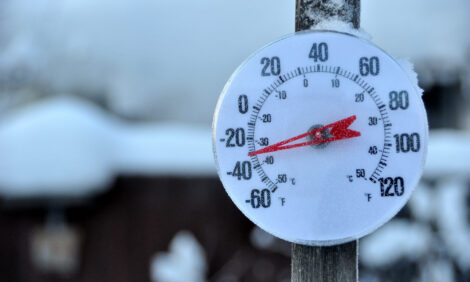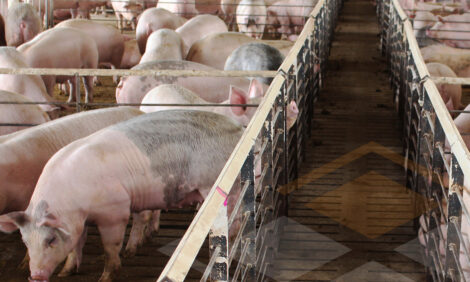



Hog Market Price Outlook - April 2003
By Chris Hurt, Extension Economist, Purdue University - In his latest monthly market report, Chris Hurt indicates the worst days of 2003 may be over for US Producers.
 Chris Hurt
Chris HurtExtension Economist Purdue University |
Summary
A profitable year for hog producers does not appear to be in the cards at this time. After much anticipation of a price recovery to near $40, the forecast has been lowered to $37.50. That is a level that will leave many producers with another year of loss. However, the worst days of 2003 may be over. Hog prices may still provide modest profits in the spring and early summer, before sinking back below cost of production in the fall.
The breeding herd is down by 4.5 percent, and farrowing intentions for this spring and summer are down about 3 percent, pointing the way to smaller animal numbers later this year and into 2004. The decline in the breeding herd is widespread geographically, with the exception of Minnesota where the herd is up 4 percent.
Cost of production has been estimated to be near $40 per live hundredweight since last summer's drought related corn price increase. Costs are not expected to drop substantially until large new crop corn and soybean crops can be assured. This will likely be into the early or mid-summer. By fall, a normal yield situation could drop costs about $2 per hundredweight to around $38, but a return to the mid $30 costs of the 1998 to 2001 period is not expected.
It appears that 2003 will be a year of improvement, but the breeding herd will have to be reduced even more before hog producer profitability can return. In historic cycles this has tended to occur, so 2004 could be the best year for returns on this cycle.
The Numbers
Financial losses over the past year have continued to discourage producers. As a result, they have decreased the size of the breeding herd, which is currently down 4.5 percent from the same period last year. This is the third consecutive, quarterly USDA report in which the size of the breeding herd has shown a decrease. The breeding herd is expected to continue to decline through the remainder of the year, with farrowings declining through the first-half of 2004.
Minnesota was the only major production state to have an increase in the size of its breeding herd, up 4 percent. Oklahoma and Texas breeding herds remained unchanged. Illinois and Iowa herds were down 7 percent, Indiana was down 6 percent, Nebraska was down 4 percent, and both Missouri and Ohio were off 3 percent. Producer decisions to decrease their herds in the eastern corn belt may have been influenced by the small corn crop (121 bushel average in Indiana and only 88 bushels per acre in Ohio). However, the record corn crop in the western corn belt does not explain hog inventory decreases in Iowa (165 bushels per acre corn yield).
The March 1 market herd was reported to be down only 1.6 percent. There is some hopeful news in the weight breakdowns. It appears that the number available for slaughter should soon begin to drop. The inventory of hogs weighing 180 pounds or more was about 1 percent larger than last year's inventory. However, most of these hogs should have been marketed by early April. The number of pigs that will come to market in April through August was down from 2 to 2.5 percent. This suggests that slaughter supplies will soon be coming down, and should provide the needed stimulus for rising prices.
Producers also say they will reduce farrowings further in coming months. After reducing farrowings by 2.4 percent this past winter, they say they will cut farrowings by 3.4 percent and by 3.3 percent in the summer quarter. If so, this will mean smaller pork supplies at least through the first quarter of 2004.
Why the Depressed Prices?
Hog prices have continued to disappoint not only producers, but also price analysts, and traders at the Chicago Mercantile Exchange who had felt that recovery would be underway early this year. So far, it has not happened. What are some of the reasons, especially given that beef prices have been high? A larger supply than expected is the word so far this year. In the first-quarter of 2003, it was expected that pork production would be down about .4 percent. However, actual production was up 2.2 percent. This was a result of about 1.5 percent more animals coming to market than anticipated, suggesting that USDA has undercounted market hogs perhaps by about 1.5 percent. In March, the slaughter rate was up by 1.8 percent and the inventory weighing over 180 pounds was up 1.2 percent, again suggesting a modest undercount in the current data.
So far this year, pork supplies are up 2.2 percent and hog prices (national base 51 percent to 52 percent lean on a live weight basis) in the first quarter of 2003 averaged $35.26 per live hundredweight. This was 11 percent lower than the $39.43 of the first quarter of 2002. Seemingly, prices are lower than the supplies would indicate and so we assume that some negative impact has been felt from the weakness in the general economy. Cold storage stocks are about 2 percent larger than year-ago levels.
The question is, are producers less willing to adjust their production today as compared to historic periods? The answer seems to be a distinct YES! Some light can be shed on this question by looking at the average yearly variability in production. Figure 1 shows the average annual variation in production over the previous 5 years. So, for example, in 1990, this number is about 5 percent. This means that in the years from 1986 to 1990, the average variation in production was 5 percent per year. The overall trend since the 1950s is to have less variable year-to-year fluctuation in production. In fact, as of 2003, that variation has dropped to only a 1.7 percent annual variation in production over the 1999 through 2003 period.
 The reasons seem to be that the industry is much more capital intensive and more specialized today. This means that it is more difficult to get in and get out of the industry and that it may require longer periods of profits, or losses, to get supply adjustment. In addition, the majority of hog facilities in the country are less than 10 years old, making it difficult for those producers to reduce production or leave the industry.
The reasons seem to be that the industry is much more capital intensive and more specialized today. This means that it is more difficult to get in and get out of the industry and that it may require longer periods of profits, or losses, to get supply adjustment. In addition, the majority of hog facilities in the country are less than 10 years old, making it difficult for those producers to reduce production or leave the industry.
Low prices are likely related to this unwillingness, or the financial inability of producers to adjust. However, if it were just this factor, one would also expect to see the period of profits be higher than usual and last longer than usual. That does not seem to be the case, and therefore one has to assume that there is also an excess production problem in relationship to total demand.
Supplies Start Dropping and Some Price Recovery
 The USDA March inventory report suggest the number of animals available to the market should start dropping immediately. The report would suggest that supplies should be down about 2.5 percent in April and May and be down about 2 percent in the June to August period. As shown in Tables 3 and 4, pork supplies are expected to be down about 2 percent for the remainder of 2003, and down somewhat over 2 percent in the first quarter of 2004.
The USDA March inventory report suggest the number of animals available to the market should start dropping immediately. The report would suggest that supplies should be down about 2.5 percent in April and May and be down about 2 percent in the June to August period. As shown in Tables 3 and 4, pork supplies are expected to be down about 2 percent for the remainder of 2003, and down somewhat over 2 percent in the first quarter of 2004.
Market weights are expected to increase with moderation in feed prices. Last summer and fall marketing weights actually fell as producers responded to higher corn prices. However, by this past winter, weights began creeping higher again. It is anticipated that market weights could rise by over 1 percent or more this summer and continue into the fall and winter, assuming a normal crop yield situation.
Estimated supplies and projected prices are shown below. The spring rally should allow prices to average near $40. Summer prices will likely drop to a couple of dollars from the spring quarter average, with fall prices moving back into the mid-$30s. The higher $30s is the call for the first quarter of 2004.
Implications
It has now been 13 months of loss for average cost pork producers. Pork supplies have not begun to decrease yet, but current inventory numbers suggests that this reduction should begin in April and continue into 2004. The breeding herd has been down now for three quarters and producers' intentions are indicating about 3 percent fewer sows will be farrowed this spring and summer.
Unfortunately, it appears that 2003 will be another year for average losses which are projected at nearly $5 per hog. However, most of this loss will be sustained in the first four months of the year. The period from May forward may well average a small profit.
The decline in the breeding herd will need to be larger to return prices to profitable levels. Discouragement among producers currently is high and it is likely that the breeding herd will in fact continue to drop even more. This may be by as much as 5 percent to 6 percent by the end of the year.
While costs of production are expected to moderate this year, growing season concerns will likely keep feed prices somewhat high until mid summer when a reasonable size crop can begin to be better assured.
Average and low costs producers should continue to stay in the industry and anticipate a much better year in 2004. However, some producers will have to get out, or reduce their production, in order to provide a breakeven world for remaining producers.
Tabular Statistics
To view the tabular statistics that go with this report Click Here
Source: Farm.Doc - April 2003






